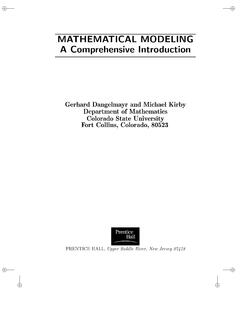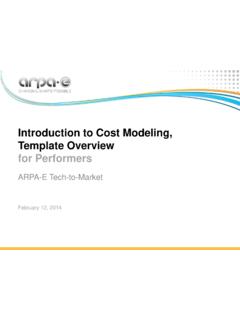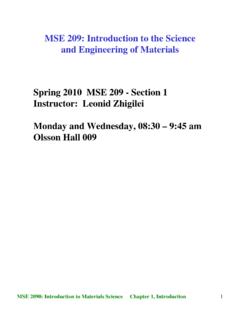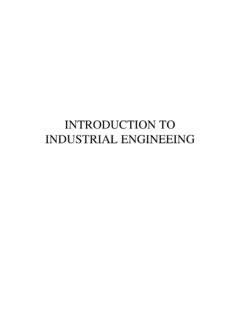Transcription of Artificial Intelligence in Modeling and Simulation
1 Artificial Intelligence in Modeling and Simulation a,b,c aBernard Zeigler, Arizona Center for Integrative Modeling and Simulation , University of Arizona,Tucson, Arizona, USA b Alexander Muzy, CNRS, Universit di Corsica, France c Levent Yilmaz, Aurburn University, Alabama Glossary 1. Definition and the Subject and its Importance 2. introduction 3. Review of System Theory and Framework for Modeling and Simulation 4. Fundamental Problems in M&S 5. AI-Related Software Background 6. AI Methods in Fundamental Problems of M&S 7. Automation of M&S 8. SES/Model Base Architecture for an Automated Modeler/Simulationist 9. Intelligent Agents in Simulation 10. Future Directions 11. Bibliography Glossary Behavior The observable manifestation of an interaction with a system DEVS Discrete Event System Specification formalism describes models developed for Simulation ; applications include Simulation based testing of collaborative services Endomorphic Agents Agents that contain models of themselves and/or of other endomorphic Agents.
2 Levels of Interoperability Levels at which systems can interoperate such as syntactic, semantic and pragmatic. The higher the level, the more effective is information exchange among participants. Levels of System Specification Levels at which dynamic input/output systems can be described, known, or specified ranging from behavioral to structural Metadata Data that describes other data; a hierarchical concept in which metadata are a descriptive abstraction above the data it describes. Model-based automation Automation of system development and deployment that employs models or system specifications, such as DEVS, to derive artifacts. Modeling and Simulation Ontology The SES is interpreted as an ontology for the domain of hierarchical, modular Simulation models specified with the DEVS formalism.
3 Net-Centric Environment Network Centered, typically Internet-centered or web-centered information exchange medium Ontology Language that describes a state of the world from a particular conceptual view and usually pertains to a particular application domain Pragmatic Frame A means of characterizing the consumer s use of the information sent by a producer; formalized using the concept of processing network model Pragmatics Pragmatics is based on Speech Act Theory and focuses on elucidating the intent of the semantics constrained by a given context. Metadata tags to support pragmatics include Authority, Urgency/Consequences, Relationship, Tense and Completeness Predicate logic An expressive form of declarative language that can describe ontologies using symbols for individuals, operations, variables, functions with governing axioms and constraints Schema An advanced form of XML document definition, extends the DTD concept Semantics Semantics determines the content of messages in which information is packaged.
4 The meaning of a message is the eventual outcome of the processing that it supports Sensor Device that can sense or detect some aspect of the world or some change in such an aspect System Specification Formalism for describing or specifying a system. There are levels of system specification ranging from behavior to structure. Service Oriented Architecture Web service architecture in which services are designed to be 1) accessed without knowledge of their internals through well-defined interfaces and 2) readily discoverable and composable. Structure The internal mechanism that produces the behavior of a system. System Entity Structure Ontological basis for Modeling and Simulation . Its pruned entity structures can describe both static data sets and dynamic Simulation models.
5 Syntax Prescribes the form of messages in which information is packaged. UML Unified Modeling Language is a software development language and environment that can be used for ontology development and has tools that map UML specifications into XML XML eXtensible Markup Language provides a syntax for document structures containing tagged information where tag definitions set up the basis for semantic interpretation. and the Subject and its Importance This article discusses the role of Artificial Intelligence (AI) in Modeling and Simulation (M&S). AI is the field of computer science that attempts to construct computer systems that emulate human problem solving behavior with the goal of understanding human Intelligence . M&S is a multidisciplinary field of systems engineering, software engineering, and computer science that seeks to develop robust methodologies for constructing computerized models with the goal of providing tools that can assist humans in all activities of the M&S enterprise.
6 Although each of these disciplines has its core community there have been numerous intersections and cross-fertilizations between the two fields. From the perspective of this article, we view M&S as presenting some fundamental and very difficult problems whose solution may benefit from the concepts and techniques of AI. 2. introduction To state the M&S problems that may benefit from AI we first briefly review a system-theory based framework for M&S that provides a language and concepts to facilitate definitive problem statement. We then introduce some key problem areas: verification and validation, reuse and composability, and distributed Simulation and systems of systems interoperability. After some further review of software and AI-related background, we go on to outline some areas of AI that have direct applicability to the just given problems in M&S.
7 In order to provide a unifying theme for the problem and solutions, we then raise the question of whether all of M&S can be automated into an integrated autonomous Artificial modeler/simulationist. We then proceed to explore an approach to developing such an intelligent agent and present a concrete means by which such an agent could engage in M&S. We close with consideration of an advanced feature that such an agent must have if it is fully emulate human capability the ability, to a limited, but significant extent, to construct and employ models of its own mind as well of the minds of other agents. 3. Review of System Theory and Framework for Modeling and Simulation Hierarchy of System Specifications Systems theory [1] deals with a hierarchy of system specifications which defines levels at which a system may be known or specified.
8 Table 1 shows this Hierarchy of System Specifications (in simplified form, see [2] for full exposition). Level Name What we specify at this level 4 Coupled Systems System built up by several component systems which are coupled together 3 I/O System System with state and state transitions to generate the behavior 2 I/O Function Collection of input/output pairs constituting the allowed behavior partitioned according to the initial state the system is in when the input is applied 1 I/O Behavior Collection of input/output pairs constituting the allowed behavior of the system from an external Black Box view 0 I/O Frame Input and output variables and ports together with allowed values Table 1: Hierarchy of System Specifications At level 0 we deal with the input and output interface of a system.
9 At level 1 we deal with purely observational recordings of the behavior of a system. This is an I/O relation which consists of a set of pairs of input behaviors and associated output behaviors. At level 2 we have knowledge of the initial state when the input is applied. This allows partitioning the input/output pairs of level 1 into non-overlapping subsets, each subset associated with a different starting state. At level 3 the system is described by state space and state transition functions. The transition function describes the state-to-state transitions caused by the inputs and the outputs generated thereupon. At level 4 a system is specified by a set of components and a coupling structure.
10 The components are systems on their own with their own state set and state transition functions. A coupling structure defines how those interact. A property of coupled system which is called closure under coupling guarantees that a coupled system at level 3 itself specifies a system. This property allows hierarchical construction of systems, , that coupled systems can be used as components in larger coupled systems. As we shall see in a moment, the system specification hierarchy provides a mathematical underpinning to define a framework for Modeling and Simulation . Each of the entities ( , real world, model, Simulation , and experimental frame) will be described as a system known or specified at some level of specification.









